Most of us have had an encounter wasp an aggressive wasp and it can be scary. It can be when you least expect it while you are out in your garden, bushwalking, or in the park with your kids. They have a reputation for being angry but are they really that dangerous?
Are Wasps Dangerous? Yes, wasps are dangerous and aggressively defend their nests or themselves if threatened. Waving arms or trying to swat wasps can make them more aggressive. Wasp stings contain venom and are painful. Wasps are dangerous because their venom can cause a life-threatening anaphylactic response.
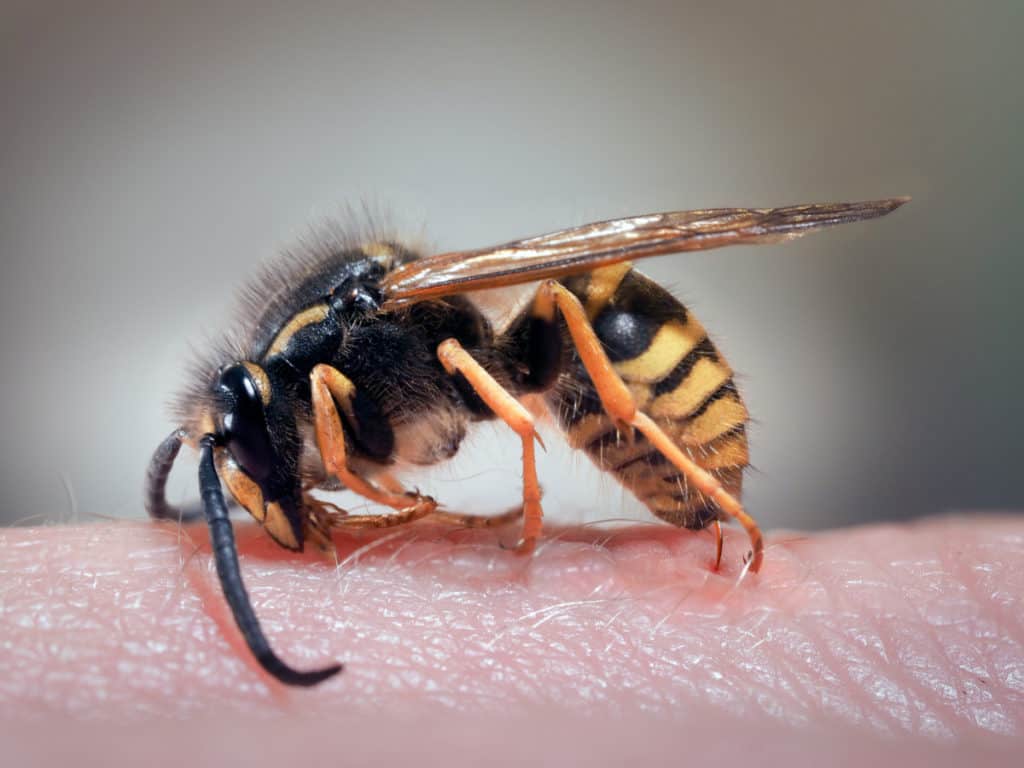
With more than 30,000 species worldwide, wasps make up an enormously diverse array of insects. However, the species most commonly encountered by people and pest control professionals are paper wasps and yellowjackets.
Many animal species even have a healthy fear of wasps and with good reason. These yellow and black striped buzzing troublemakers can be dangerous and appear aggressive.
Generally, they are not aggressive unless provoked or their nest threatened. However, when irritated enough they will attack. They defend their nests from threats or encroachment into their territory by stinging.
Wasps occur in two primary subgroups; solitary and social. Both groups have species that will sting. You are might be aware of the formidable colony-building social wasps like yellowjackets, paper wasps, and hornets. These guys use their stingers as a defensive mechanism.
Stinging solitary wasps such as the Great Black Wasp and the Great Golden Digger also rely on their venom to hunt.
Let’s look at the common wasps that can sting to understand the danger they pose to humans.
Stinging Solitary wasps
Most wasps are actually solitary nonstinging varieties. They do not form colonies and are by far the largest subgroup with each adult female living and breeding independently.
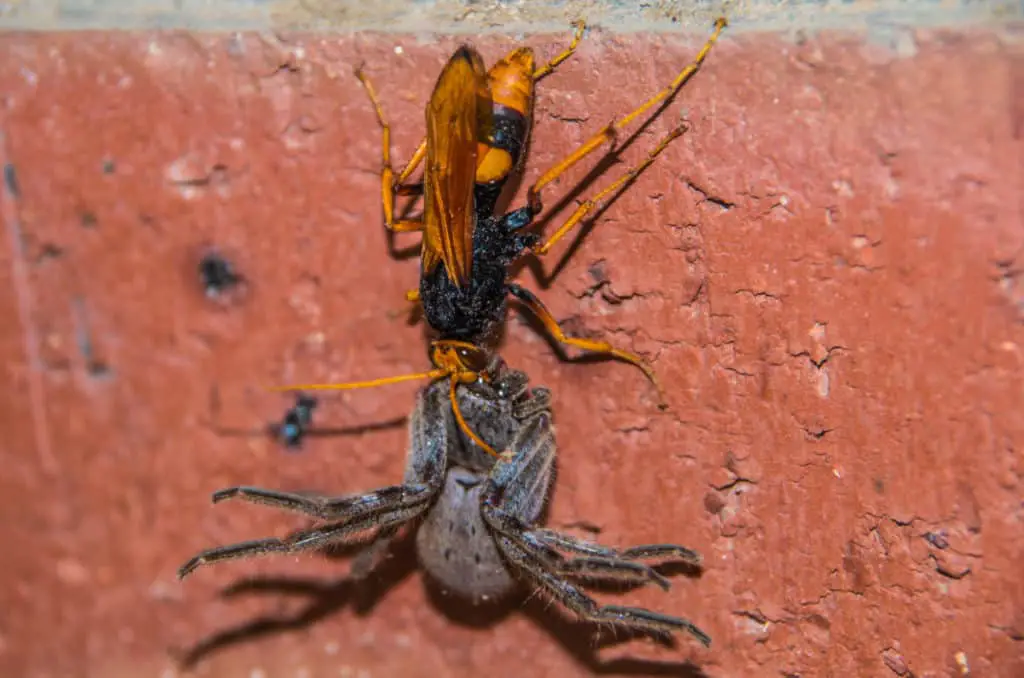
Solitary wasps are carnivorous predators that capture and paralyze insects or spiders to feed their young. Many species specialize in a particular type of prey. Solitary female wasps build provision nests and are independent of one another. They sting and paralyze their prey before dragging it back to the nest for the larvae to feed on.
Species of wasps in this group that have the ability to sting include, the spider wasp, mason wasp, potter wasp, mud daubers, cicada killer wasps, great golden digger wasp, and the great black wasp.
If you are interested we have a detailed article on the diets of wasps. The article is called, What Do Wasps Eat?
Stinging Social Wasps
Social wasps use their stingers only for defense. Paper wasps are semi-social insects as they typically live in small colonies and do not have a worker caste. There are about 22 known paper wasps species occurring in North America, and many others in their hundreds across the world.
This type of insect includes species such as;
- Annularis paper wasp
- Apache paper wasp
- Dominilus paper wasp
- Dorsalis paper wasp
- Golden paper wasps
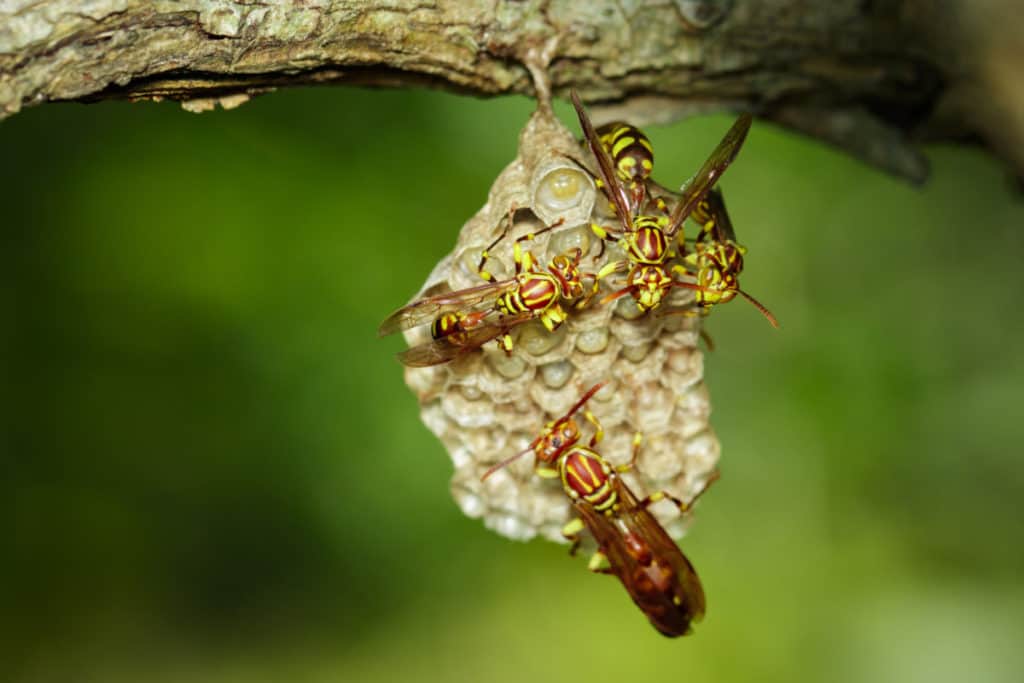
Similar groups in this category include yellowjackets, hornets, and, umbrella wasps.
If you are interested we have a couple of articles comparing some of these wasps. If you want to check them out the links are below:
When Do Wasps Sting?
Wasps live in the whirl of late summer and their stings are common especially during the warmer months when people tend to spend more time outdoors. They sting mostly in self-defense when they are provoked or threatened as previously mentioned.
When their nest is disturbed, vespid wasps are most likely to sting. All social wasps put up a vigorous defense of their nest when disturbed although they rarely sting away from the nest.
They will sting if they are pressed against the skin. Wasps and bees are instinctively attracted to the upper bodies of animals in an attack. In the event of an attack, it is best to cover your head and run away quickly.
Wasps may sting multiple times because they do not leave a stinger in the skin, unlike honey bees. On top of that, to make these pesky creatures even scarier, they can call for a backup by releasing pheromones. Victims who don’t run away and attempt to swat the notorious insects will continue receiving stings.
The venom of solitary wasps is different from that of social wasps and rarely causes more than momentary pain. Solitary wasps, unless mishandled or trapped against the skin, rarely sting. They do not build a community nest and therefore they do not attempt to defend their nest en-masse.
What Wasps Are Mostly Likey To Attack And Sting You?
There is nothing like the feeling of pain and panic after being stung by wasps, BAM, then BAM BAM. Immediately realizing you are under attack and you instinctively flap your arms and like the cartoon character Roadrunner, your legs run as they have never run before.
If you have experienced this then you know what I am talking about and if you haven’t I hope you never do. Here are the two types of wasps that are most likely to really attack you if you disturb them:
- Paper Wasps
- Yellowjackets
Paper Wasps
Paper Wasp Nests
Paper wasps are a species of wasp that feeds on the nectar and pollen of plants. Most paper wasps are around 0.5 to 1.5 inches long. They are brownish in color with yellow or reddish markings.
They construct their nest from paper-like material from which they get their name. They create umbrella-shaped nests from plant materials and saliva formed into nests consisting of multiple compartments that are not covered or enclosed in an envelope.
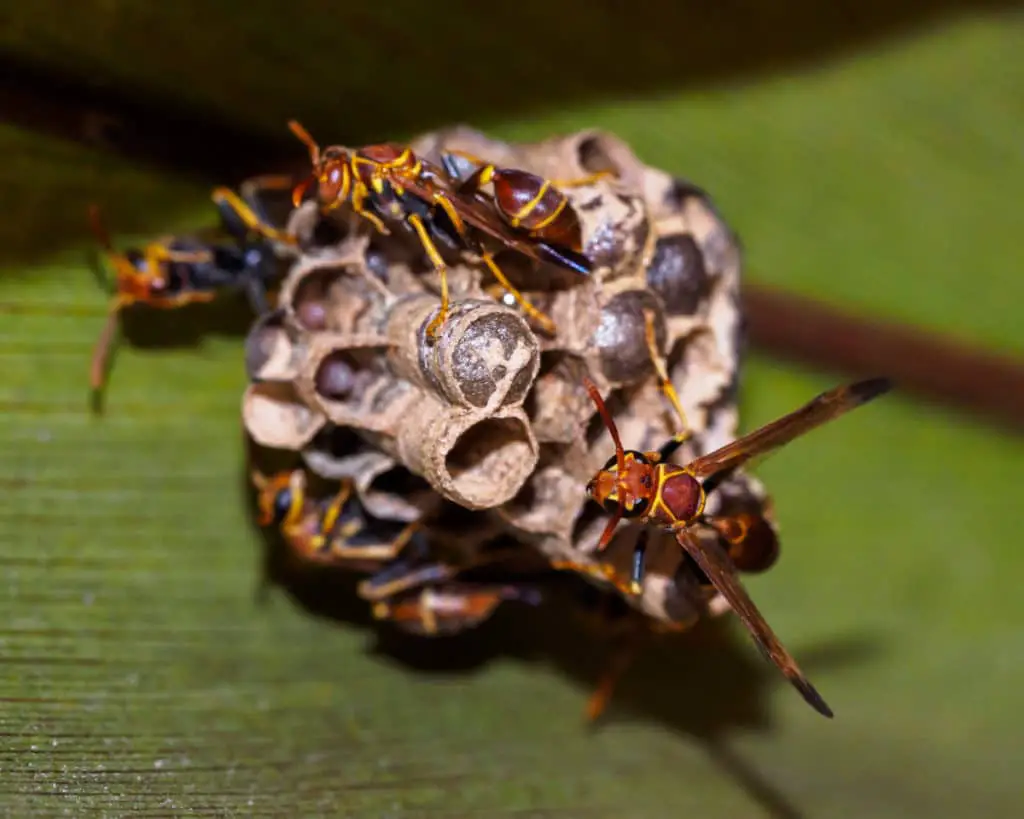
The paper wasps lay eggs in these compartments and raise their offspring in them. Nests are often found hanging from twigs and branches of trees and shrubs. Porch ceilings, door frames, eaves, deck floor joints, railings, and other protected areas are also places preferred by nesting paper wasps.
Paper Wasp Aggression
Although paper wasps are typically not an aggressive species, there is a high probability you will get stung if a nest is disturbed. These insects are territorial and they will protect their territory from encroachment by stinging intruders or perceived threats. Nests near structures pose a risk and control is warranted.
Yellowjackets
Most of these wasps can be identified by their distinctive black and yellow markings. They are between 3/8 to 5/8 inches long. Some are black and white like the bald-faced hornet while others may have red as the background color on their abdomen. Yellowjacket is the common name in North America. Other English-speaking countries simply call them “wasps”.
All yellowjackets females are capable of delivering painful stings.
Yellowjacket Nests
Yellowjackets prefer to build nests in locations that are close to food and water sources where they forage to feed their larvae insects and spiders. They build nests that are surrounded by a papery covering. The many-layered envelope will contain several rounded paper combs attached one below another. Nests are commonly found within wall voids or cavities.
The nest may be near the ground, such as on plant roots, logs, or timber. Yellowjackets also construct aerial nests attached to shrubs, bushes, houses, garages, and sheds. The location depends on the species.
If you are interested we have an article that compares wasps nests to honey bee hives. The article is called Wasps Nest Vs Beehive. How Different Are They, Really?
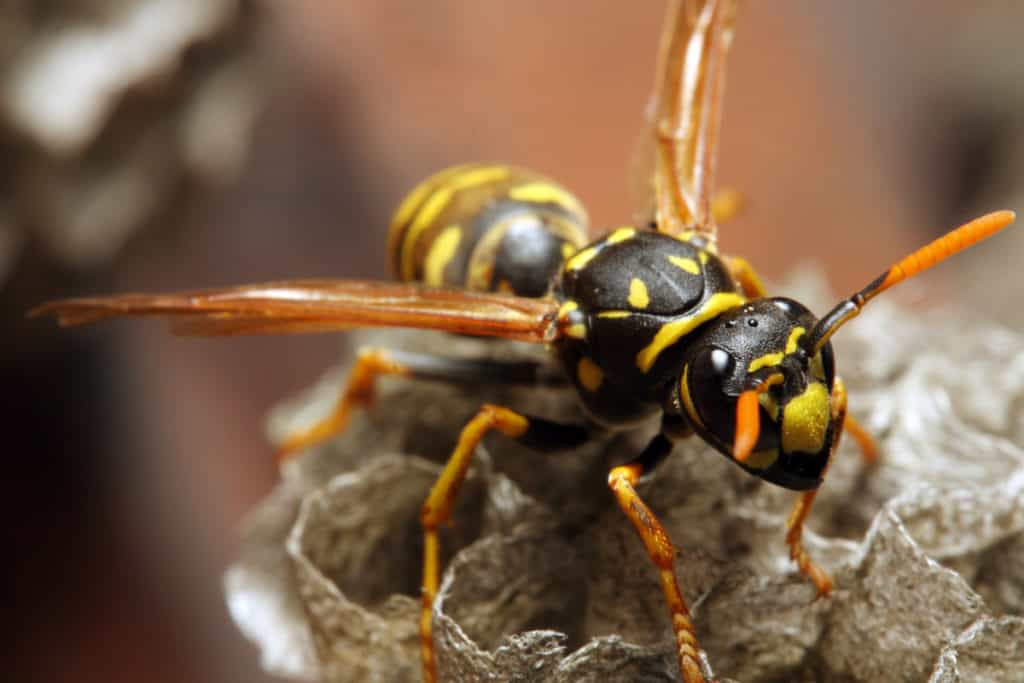
Yellowjackets have a scavenging behavior around parks, camps, and suburban sites where open or discarded foods like meat, fruit, or sweet drinks like soda are left by people. To supplement their diet they also feed on nectar and honeydew as a carbohydrate source.
Yellowjacket Aggression
Yellowjackets usually keep to themselves and unless their nests are threatened or provoked, they are slow to sting. Yellowjackets play an important role in the control of numerous pest insect species. However, control may become necessary if their nest is located near a human dwelling structure.
What Happens If You A Stug By A Wasp?
Even though the wasp sting is not the best feeling in the world, a majority of people experience a quick recovery without complications. The pain and swelling usually recede within several hours of being stung. A raised welt is likely to develop around the sting site. In the middle of the welt, a visible tiny white mark will appear.
The wasp stinger does not detach from the wasp when the wasp stings but punctures the skin. The stinger transmits venom to humans during a sting.
Wasp stings release toxins that can be harmful to humans and mammals alike. Dogs, cats, and birds are all susceptible to wasp venom.
The majority of people without sting allergies will show only minor symptoms in case they are stung by a wasp. However, they will experience sharp pain or burning sensations at the sting site as well as redness, swelling, and itching.
If you are allergic to wasp venom, it can cause a serious reaction and you should seek treatment right away to alleviate symptoms and avoid complications.
Wasp Stings Can Cause A Serious Local Reaction
When pain and swelling extend beyond two inches from the site of the sting and causes pronounced symptoms it is referred to as a “Large local reaction”. The reactions include extreme redness and swelling that increase for two to three days after the sting.
These may not be life-threatening symptoms such as anaphylactic shock but might occur in people who are allergic to wasp stings.
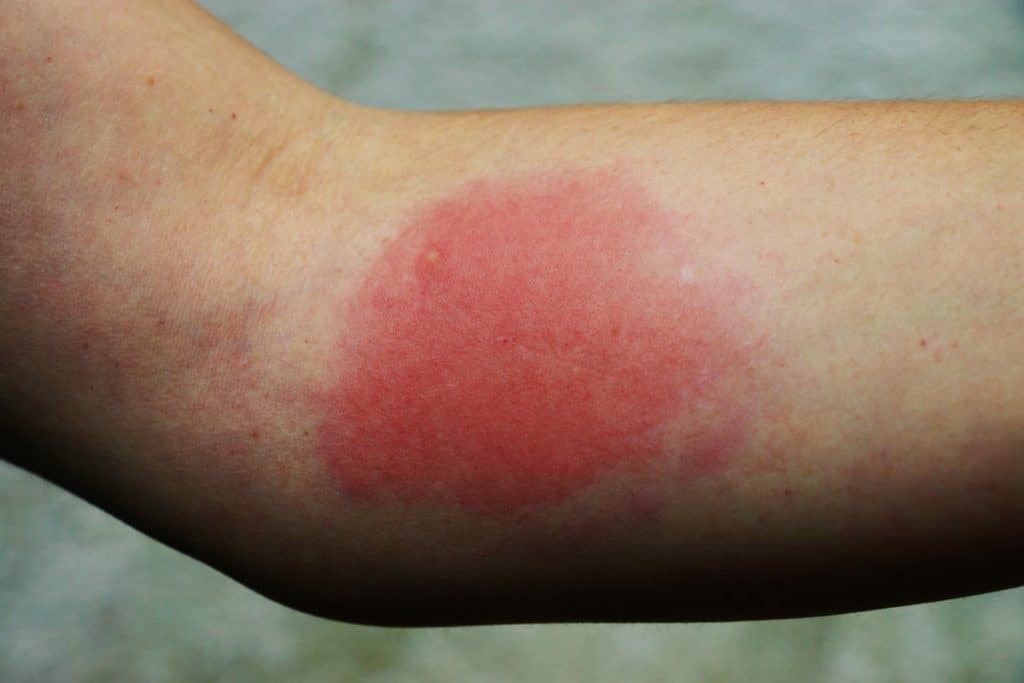
More often than not, large local reactions go away on their own over the course of a week or so. To reduce your discomfort to a large local reaction after a wasp sting, your doctor may direct you to take an over-the-counter (OTC) antihistamine medication.
You may not always react to future stings in the same way after having a large local reaction one time. Your body could have one strong reaction once and that could be all. On the other hand, your body could routinely respond with a large local reaction to wasp stings. Avoiding wasp stings is the best way to minimize risks associated with wasp venom.
Anaphylaxis From Wasp Stings
Anaphylaxis is a medical emergency that should be attended to immediately. It refers to the most severe allergic reactions to a wasp sting(s). Wasp venom may trigger a response that can cause your body to go into shock. This happens very quickly after a person is stung by a wasp. Prompt emergency care to treat anaphylaxis is important as it can quickly become life-threatening.
Severe allergic reaction to wasp stings can include some, but not all, of the following symptoms:
- Severe swelling of the face, lips, or throat;
- hives or itching in areas of the body not affected by the sting;
- breathing difficulties, such as wheezing or gasping;
- dizziness;
- a sudden drop in blood pressure;
- reeling sensation as if you might faint;
- loss of consciousness;
- diarrhea;
- stomach cramps;
- a weak or racing pulse;
Anaphylaxis typically occurs within 20 to 30 minutes of a sting. In severe reactions, shock and death can occur as quickly as 10 to 15 minutes.
For people who are allergic to bee or wasp venom, a life-saving epinephrine emergency kit or self-administer antihistamine should be carried around after consulting with your physician.
What To Do After A Wasp Sting
Wasp stings are without a doubt very painful and symptoms can quickly overwhelm a person with an allergic reaction. It is recommended that after a wasp sting you do the following;
- Wash the site with cool water to remove the venom.
- Treat with an antihistamine product that can help ease the pain.
- Should you start to experience dizziness, fatigue, nausea or trouble breathing, then immediately seek medical attention.
- Keep the wound clean and dry to prevent infection.
- Cover with a bandage if desired.
If the wound remains hot and inflamed for longer than 8 to 12 hours, it could be a sign of infection that may result in sepsis. Wasp stings may transfer harmful bacteria, in case of an infection, it is prudent to see your physician and get advice on bringing the infection under control without further complications.
The Wrap Up
Wasps can be dangerous especially to people with allergic reactions to bee or wasp stings. They can be fatal if a person is stung and goes into anaphylactic shock and does not receive immediate medical attention.
Wasps generally are not aggressive unless they are disturbed or provoked. You should avoid or keep away from their nest. Wear shoes when walking outdoors to avoid stings should you step on a wasp nest on the ground.
For all the pain a wasp sting may cause, these insects remain important to the environment because they keep harmful pest species under control.
Whatever you do, avoid the removal of a stinging insect nest on your own as such attempts can be extremely dangerous. It is best to work with a licensed pest control professional who can help identify the type of stinging Insect and determine the best way to deal with the threat.
If you are interested we have written some other article the discuss whether some other bugs are dangerous. The links to these articles are below if you want to check them out:
Do Carpenter Bees Sting And Does It Hurt?
Sources
https://agrilifeextension.tamu.edu/library/insects/paper-wasps-yellowjackets-and-solitary-wasps/
https://www.healthline.com/health/wasp-sting#complications
https://www.terminix.com/blog/bug-facts/7-facts-about-paper-wasps/
https://en.m.wikipedia.org/wiki/Yellowjacket
https://www.bigbluebug.com/pest-identification/profile/paper-wasps
https://www.arrowexterminators.com/learning-center/pest-library/stinging/paper-wasp
